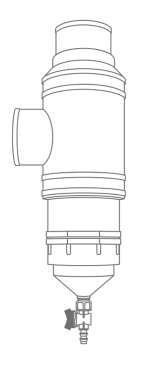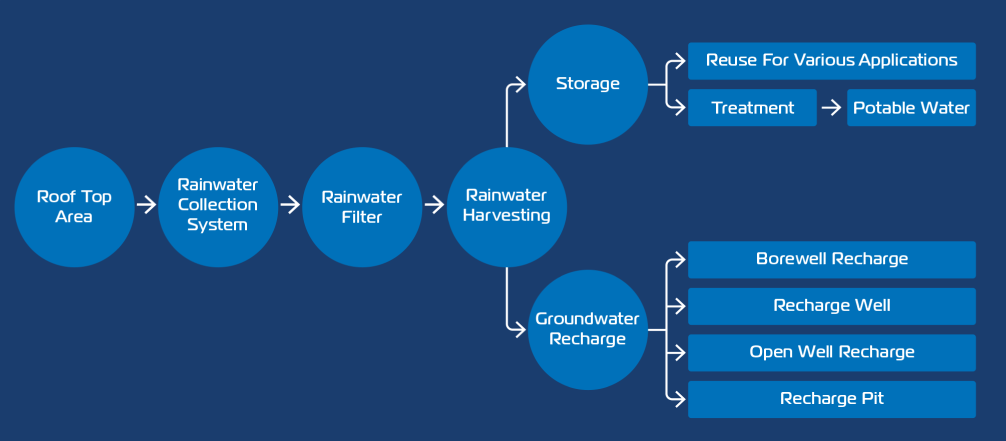Our innovative
Technology
Rainwater Harvesting Filter
A result of several years of R & D, with feedback from plumbers and customers, conducted by a highly professional team of engineers and Bangalore Water Supply and Sewage Board (BWSSB) & Karnataka State Council for Science and Technology (KSCST) certified experts
Deepleen Rainwater Harvesting Filter
Deepleen filter is a very important component of any rainwater harvesting system. deepleen rainwater filter is uniquely designed to remove suspended leaves, dirt, debris or any suspended solid particles in the rainwater collected from the roof. The filter unit is provided with a 240 Micron stainless steel cartridge for effective filtration before it is allowed to enter into the storage tank/recharge pit/well. This filter with self-cleansing ability works on the principle of gravity without any need of external power supply.

Rainwater Harvesting System
Rainwater from the building roof top is normally collected using a open or closed piping systems, roof gutter system or closed conduits. It is mandatory to filter the rainwater before allowing it to be harvested. Storage of filtered water for reuse using storage tanks and/or recharging ground water are the two ways of rainwater harvesting. Thus any rainwater harvesting system comprises – rainwater collection system, filters, storage tank/ground water recharge pit/recharge well/bore well. Normally rainwater filters are mounted on the exterior face of a wall little above the ground level where down-take rainwater pipe can be directly connected to inlet of the filter. The Food-Grade Stainless Steel Cartridge fitted in the filter unit removes suspended solid particles through drain outlet at the bottom and filtered water is discharged through a pipe connected to the outlet. This filtered water can be discharged to either a storage tank for reuse or for recharging ground water
Flow Chart

Unique Features
- Works on the principle of gravity
- Unique, compact and stable design – deepleen filters have a unique design which efficiently filters the rainwater entering into it using food-grade stainless steel cartridge
- Strong, durable and long lasting – Filters are sufficiently strong to withstand all kinds of impact that there will be no wear and tear, thus it lasts for a long time and provide trouble free service
- High and consistent filtration efficiency – Design of the filter and the cartridge is such that this unit gives more than 90% filtration efficiency enabling maximum utilization of rainwater, reducing wastage
- The filter efficiency remains constant even with variation in the intensity of rainfall
Various Models from 100 – 15000 sqft roof areas – More filters can be used for larger areas with additional down-take pipes
- Flexibility in pipe connection for any angle and degree – Filters are designed in such a way that they can adopt incoming down-take rainwater lines in any direction. Similarly outlet of the filter can also be connected to any angle of delivery pipes.
- Simple and quick installation – Being compact in design and light in weight, these filters can easily be fitted in a very short time.
- Self-cleaning mechanism – Ball-valve free, automatic removal of suspended solids is a great feature.
- Easy to inspect and maintain through large inspection opening – Filter body is provided with large sized threaded cap which can easily be opened for cleaning and maintenance
Its unique gravity based design filtration system makes it free from any manual operation unlike other filters in market. The efficiency rate of filtration is high even with less density of rain, ensuring low wastage of water during filtration process.
Rainwater Harvesting Methods

Storing the filtered rainwater in the underground water storage tank for reutilization for different purposes

Recharging the borewell by directly connecting of filter outlet to the borewell casing pipe

Recharging dried and/or yielding borewell through a recharge well adjacent to the borewell

Recharging open dug well by discharging filtered rainwater in the well
How deepleen is superior to other Rainwater Filters?
- deepleen rainwater harvesting filter can be used as a simple filter for eliminating dust, debris, leaves and suchlike.
- It works on gravity based system, which does not require manual operations, like operating ball valves each time it rains.
- Thanks to its gravity based ln-Built Auto First-Flush system, it does not permit initial rain (Acidic Rain) and other debris to enter the storage system.
- deepleen consists of Food Grade 304 Stainless Steel double layer life-long working filtration cartridge which is more hygienic, when compared to plastic and sponge based filtration system.
- Self-Cleaning gravity based mechanism makes it easy to maintain and does not require cleaning each time when it rains.
- Unlike the vast majority of filters in the rainwater harvesting industry, deepleen Filter is available for downpipes from 75 mm – 250 mm
Installation Procedure
- Prior to rainy season, clean the entire roof area for quick collection of rainwater.
- Fix the location of rainwater filter on the wall according to available space, gradient and distance of storage tank or recharge pit
- Mark the position of wall mounting brackets as per vertical alignment and pipe direction. Check the horizontal alignment of brackets using spirit level.
- Drill holes on the marked points for mounting the brackets
- Fix the brackets on the wall using concrete nails on the marked positions. Fix the clamps on bracket using nut bolts.
- Install the filter body at its place using outer clamps and nut bolts and make the inlet/outlet connections
- Fix inlet and outlet pipes using pipe clamps to avoid vibration
Advantages of Rainwater Harvesting
- Around 30 to 40 % of annual requirement of household water can be met by storing and utilization of rainwater
- Considerable amounts spent on water and power bills can be saved due to reduction in pumping of water from distant places and deeper depths
- Reduces the dependency on corporation water supply, water tankers and ground water
- Reduces hardness, salinity and TDS contents in the bore well
- Prevents water logging in low lying areas
- Recharge of groundwater helps in improving water table
- Reduces loss of top soil and surface runoff which avoids silting of ponds and lakes
